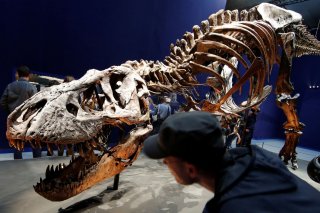Can Scientists Tell Male and Female Dinosaurs Apart?
It's not as easy as you might think.
For decades, scientists have questioned our ability to accurately identify the sex of dinosaurs.
Now, according to new research led by Queen Mary University of London, that lack of confidence was indeed merited, as the study points out that it’s incredibly difficult to discern gender in these animals.
The study’s findings have been published in the journal PeerJ.
In arriving at this conclusion, the researchers analyzed skulls from modern-day gharials, which are a critically endangered giant crocodilian species, and tried to see if they could distinguish the sex using only fossil records. These long-snouted reptiles can reach nearly 20 feet in length and have been referred to as “living dinosaurs.”
Male gharials are physically larger than their female counterparts and feature a fleshy growth on the end of their snouts—known as a ghara. Made of soft tissue, the ghara is supported by a bony hollow near the nostrils, which is known as the narial fossa.
The research team was able to study 106 gharial specimens housed in museums worldwide, and aside from recognizing the presence of the narial fossa in males, it was still very difficult to distinguish between the sexes.
The lack of visually observable differences between male and female gharials—other than a bony hollow in the skull—confirms that it would have been rather difficult to tell male and female dinosaurs apart. It is hard to determine the gender from only skeletons as well.
“Like dinosaurs, gharials are large, slow growing reptiles that lay eggs, which makes them a good model for studying extinct dinosaur species,” the study’s author Dr. David Hone said in a statement.
“Our research shows that even with prior knowledge of the sex of the specimen, it can still be difficult to tell male and female gharials apart. With most dinosaurs we don’t have anywhere near that size of the dataset used for this study, and we don’t know the sex of the animals, so we’d expect this task to be much harder.”
In many animals, males and females can look very different from each other—known as sexual dimorphism. For example, male deer often feature antlers and the females do not. Such differences, however, aren’t readily apparent in dinosaurs.
“Some animals show extraordinarily high levels of sexual dimorphism, for example, huge size differences between males and females,” Hone said. “Gharials sit somewhere in the middle as they do possess these large narial fossa that can help with identification. Our study suggests that unless the differences between the dinosaurs are really striking, or there is a clear feature like the fossa, we will struggle to tell a male and female dinosaur apart using our existing dinosaur skeletons.”
The research also challenges the conclusions made by previous studies that tried to pin down the gender differences in Tyrannosaurus rex.
“Many years ago, a scientific paper suggested that female T. rex are bigger than males,” Hone said. “However, this was based on records from 25 broken specimens and our results show this level of data just isn’t good enough to be able to make this conclusion.”
Ethen Kim Lieser is a Science and Tech Editor who has held posts at Google, The Korea Herald, Lincoln Journal Star, AsianWeek and Arirang TV. He currently resides in Minneapolis.
Image: Reuters

